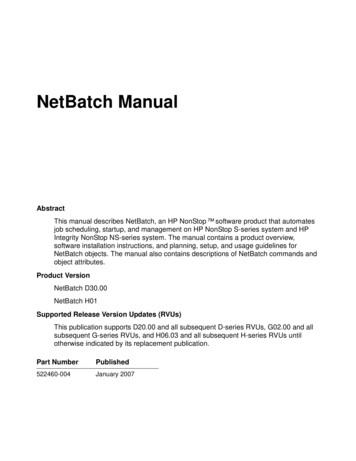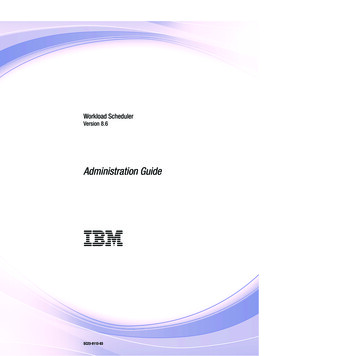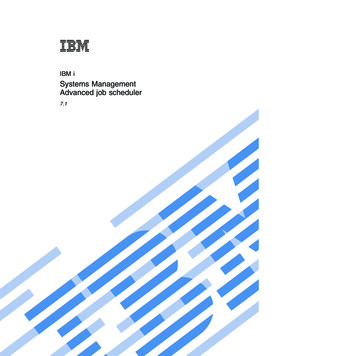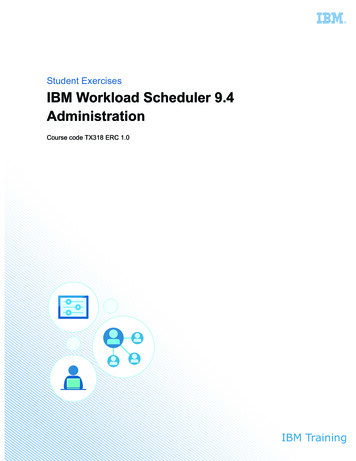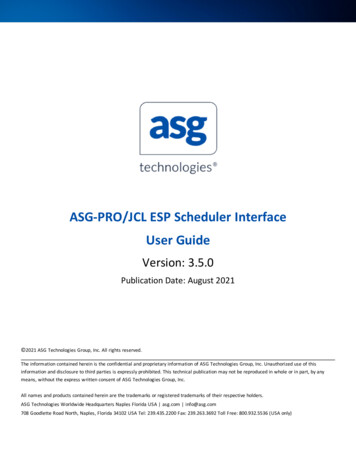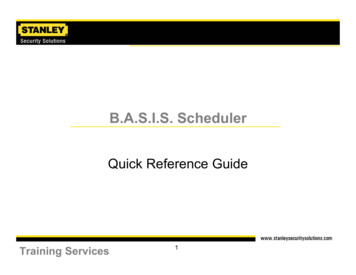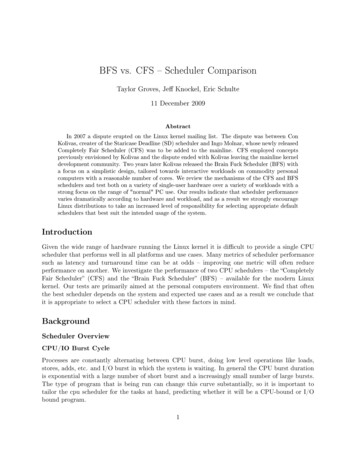
Transcription
BFS vs. CFS Scheduler ComparisonTaylor Groves, Je Knockel, Eric Schulte11 December 2009AbstractIn 2007 a dispute erupted on the Linux kernel mailing list. The dispute was between ConKolivas, creater of the Staricase Deadline (SD) scheduler and Ingo Molnar, whose newly releasedCompletely Fair Scheduler (CFS) was to be added to the mainline. CFS employed conceptspreviously envisioned by Kolivas and the dispute ended with Kolivas leaving the mainline kerneldevelopment community. Two years later Kolivas released the Brain Fuck Scheduler (BFS) witha focus on a simplistic design, tailored towards interactive workloads on commodity personalcomputers with a reasonable number of cores. We review the mechanisms of the CFS and BFSschedulers and test both on a variety of single-user hardware over a variety of workloads with astrong focus on the range of "normal" PC use. Our results indicate that scheduler performancevaries dramatically according to hardware and workload, and as a result we strongly encourageLinux distributions to take an increased level of responsibility for selecting appropriate defaultschedulers that best suit the intended usage of the system.IntroductionGiven the wide range of hardware running the Linux kernel it is di cult to provide a single CPUscheduler that performs well in all platforms and use cases. Many metrics of scheduler performancesuch as latency and turnaround time can be at odds improving one metric will often reduceperformance on another. We investigate the performance of two CPU schedulers the CompletelyFair Scheduler (CFS) and the Brain Fuck Scheduler (BFS) available for the modern Linuxkernel. Our tests are primarily aimed at the personal computers environment. We nd that oftenthe best scheduler depends on the system and expected use cases and as a result we conclude thatit is appropriate to select a CPU scheduler with these factors in mind.BackgroundScheduler OverviewCPU/IO Burst CycleProcesses are constantly alternating between CPU burst, doing low level operations like loads,stores, adds, etc. and I/O burst in which the system is waiting. In general the CPU burst durationis exponential with a large number of short burst and a increasingly small number of large bursts.The type of program that is being run can change this curve substantially, so it is important totailor the cpu scheduler for the tasks at hand, predicting whether it will be a CPU-bound or I/Obound program.1
Filling the IO GapWhen a process makes a request for I/O such as a system call like read(), if the device driverthat handles the request is busy then process is put on a wait queue.The driver is responsiblefor generating an interrupt, which wakes up this thread once the request for I/O has been ful lled.Once a process has been determined to be idle, its the schedulers job to select a process from thegroup of ready processes and allocate the CPU to that process.After an I/O request has been ful lled an interrupt is triggered and if the thread can run again, aneed resched ag is set for the scheduling data structure. When a process is restarted the dispatcherhandles the context switch change in user mode, and ensures that the program restarts from theproper location.Some sort of data structure manages the order that the scheduler pulls a process from memoryfor execution. This can be anything from a FIFO queue to a red-black-tree, but all schedulers usethis data structure with some unit of measurement such as CPU burst duration, order of requests,or priority.What's important when comparing schedulersIt is important CPU schedulers to maximizeCPU utilizationThroughputHow saturated the CPU is from 0 to 100%.The number of processes completed per unit of time.It is important for CPU schedulers to minimizeTurnaround timeWaiting timeThe total time taken for a process to complete once started.The total time a process spends in the ready queue.Scheduler latencyThe time between a wakeup signal being sent to a thread on the wait queueand the scheduler executing that thread. Including the dispatch latency the time taken tohandle a context switch, change in user-mode, and jump to starting location. Reducing Scheduler LatencyRunning the scheduler more frequently will reduce scheduler latency since a thread will spendless time waiting in the ready state. However, there is a trade-o since running the schedulermore frequently will result in more time spent scheduling and less time actually performingthe task at hand.Ideally the scheduler will run as soon as possible, after a interrupt has occurred which wakesup a thread.Di erent Strokes for Di erent FolksMost of the criteria for determining a good scheduling algorithm depends on the type of work beingdone on the machine. In general this work can be classi ed into three categories: Batch, Interactive,and Real Time.2
Batch: this category is less concerned with timing and latency but rather seeks to maximizethe amount of work accomplished in a given time. Batch workloads are characterized by lackof user interaction. Interactive: being able to service the user quickly is paramount.Schedulers that focus oninteractivity respond to input like key strokes consistently with a low variance and low averagetime to wake up a sleeping process. Real-Time: Systems focused on real-time processes such as live video encoding with multimedia playback, or sensor networks and will want to reduce latency and variance and strictlyenforced priorities. The requirements of the scheduler for systems that are focused on real-timeprocesses are the most stringent of the three categories.Con Kolivas and LKMLCon Kolivas the author of the BFS is an anesthesiologist by trade. A timeline of his involvementin the Linux kernel development is provided 1. His relationship with the Linux kernel developerswas often times fractious, and there is an extensive online record of their public arguments1 2.Scheduler ImplementationsMultilevel Feedback Queues And The O(1) SchedulerMany commodity operating system schedulers use multilevel feedback queues. These include Linuxprior to 2.6.23, as well as Windows NT-based operating systems such as Windows XP, Vista, and73 . These schedulers use separate queues to give preference to interactive and I/O bound tasks.These tasks are prioritized to increase interactivity and I/O utilization.With multilevel feedback queues, new tasks are initially queued into a middle priority queue.If a task uses its entire timeslice, then it is moved down to a lower priority queue.If a taskblocks before its time timeslice is up, then it is placed in a higher priority queue. Depending onthe implementation, to reward I/O bound tasks, tasks on higher priority queues can have longertimeslices and be scheduled before tasks on lower priority queues.Consider Linux prior to 2.6.23, which uses the O(1) scheduler so named because selectingthe next task to run takes at most a constant amount of time.The O(1) scheduler implementsa multilevel feedback queue similar to the above. With this scheduler, tasks start with an initialstatic priority, or niceness, in the range of [-20,20) where a lower niceness is a higher priority. Thetasks priority is adjusted depending upon its perceived interactivity. Higher priority tasks a givenlarger timeslices and preferential scheduling4.The O(1) scheduler guarantees constant runtime by maintaining two runqueues per CPU, theactive runqueue and the expired runqueue. These queues are implemented using a FIFO list foreach possible priority. After a task uses its timeslice its priority is potentially modi ed, and it isplaced on the expired runqueue. After all tasks on the active runqueue have been given time on theCPU the expired runqueue is swapped with the active runqueue. Since all of these operations areO(1), the O(1) scheduler is justi ed in its ck/7850http://marc.info/?l linux-kernel&m 125229579622556&w terfriendly.aspx?p 101760&rll 1123
1. Kolivas releases an updated versionnamed the Rotating Staircase DeadlineScheduler (RSDS)a . Linus seemsamenable to inclusion of RSDS into thekernel mainline2. RSDS develops into the StaircaseDeadline (SD) scheduler3. Ingo Molnar releases the CompletelyFair Scheduler (CFS) which uses manyof the ideas rst proven in Kolivas' SDscheduler4. Kolivas leaves Linux kernel developmentKolivas is interviewedaboutConTestababenchmarking toolgaining popularityamong kernel devs1999aKolivas begins following Linux Kernel development. Soon hebegins managing ode/4652002b20042009Kolivas releases his2007 Staircase scheduler a kml/2004/3/24/208Kolivas is inspired by an xkcd cartoon to release the Brain FuckScheduler .Figure 1: TimelineSince the O(1) scheduler maintains a runqueue pair per CPU, separate CPUs rarely try to accessthe same runqueue, and tasks tend to stay on the same processor. Because of these properties, theO(1) scheduler scales well to highly parallel systems; however, the scheduler must occasionallyperform explicit load balancing to ensure tasks are evenly distributed over all CPUs5.One problem with schedulers implemented using multilevel feedback queues is di erentiationof CPU bound tasks from I/O bound tasks. Consider a scheduler that always rewards a task thatblocks before its timeslice is up. Then a malicious user could write a task that blocks moments beforeits time slice has expired in order to be e ectively CPU bound but still acquire the privileges of anI/O bound task. To help ameliorate this problem, the O(1) scheduler uses complicated heuristicsto detect when a task is I/O bound. However, in practice, this adds more exploitable corner casesand the problem quickly devolves to a game of cat and mouse.4
Prioritytask 124-2task 108-10task 72task 104task 80task 88task 204task 1002task 98Figure 2: O(1) Scheduler data structuretask 123vr 801task 102vr 482task 194vr 504task 111vr 907task 204vr 794task 105vr 810task 388vr 944Figure 3: CFS scheduler data structureFair Scheduling And The Completely Fair SchedulerThe Completely Fair Scheduler (CFS) was written by Ingo Molnar.It was o cially included inLinux 2.6.23, and it seeks to address a number of problems with schedulers, including issues offairness and malicious users.CFS is an implementation of fair-share scheduling policy. A fair-share scheduling policy dividesthe CPU time among entities, such as users, groups, or tasks themselves. Although CFS supportsfair-share scheduling on the user and group levels, its name originally refers to fair-share schedulingon the task level.Ingo Molnar explains this by using the thought experiment of an ideal, multi-tasking CPU6.This CPU runs each task in parallel at an equal fraction of the CPU's speed. For instance, if fourtasks are running on it, then each task runs at 25% speed. On this hypothetical CPU, there is nostate in which one task has gotten more of the CPU than another, since all tasks are running on itat once, so all tasks have a fair share of the CPU.CFS models this hypothetical processor by keeping track of how unfairly each task has ary/l-scheduler/http://lwn.net/Articles/357451/5
treated relative to the others. On the hypothetical ideal CPU, unfairness would always be zero butsince a real CPU can only schedule a nite number of tasks at a time, unfairness will inevitably benonzero when there are more tasks than CPUs. When one task is running on a CPU, this increasesthe amount of CPU time that the CPU owes to all other task. CFS schedules the task with thelargest unfairness onto the CPU rst.CFS manages tasks using a red-black tree. Inside of the tree, tasks are in descending order bytheir total unfairness, i.e., by the time of their future execution since the task presently beingtreated the most unfairly will be scheduled next. The scheduler selects the next task by followingleft nodes to choose the leftmost node in the red-black tree. Because it uses a red-black tree CFS,requires O(logn) time to schedule a task where n is the number of tasks.When a task has nished running on the CPU, all of the other tasks in the tree need to havetheir unfairness increase.To prevent having to update all of the tasks in the tree the schedulermaintains a per-task vruntime statistic. This is the amount of total nanoseconds that the task hasspent running on a CPU weighted by its niceness. Thus, instead of updating all other tasks to bemore unfair when a task has nished running on the CPU, we update the leaving task to be morefair than others by increasing its virtual runtime. The scheduler always selects the most unfairlytreated task by selecting the task with the lowest vruntime.When a new task is created, it is assigned the minimum current vruntime. To facilitate this, theminimum vruntime statistic must also be maintained. This minimum vruntime value is also usedto handle over ow of the vruntime value so that vruntime - min vruntime can be reliably used tosort the red-black tree.With CFS, tasks have no concept of timeslice but rather run until they are no longer the mostunfairly treated task.granularity.To reduce context switching overhead.CFS divides time into a minimumThe granularity value can be used to control the tradeo between overhead due tocontext switching and latency7.When a task is awakened from blocking, its new vruntime is the larger of its old vruntimeand min vruntime - sched latancy, where sched latency is a time constant. Thus, if a task hasbeen blocking long enough, then its vruntime will be sched latency smaller than the currentlyscheduled task, assuring that the currently running task will be preempted and the awakened taskwill be scheduled. Using min vruntime - sched latency as a lower bound on an awakening task'svruntime prevents a task that blocked for a long time from monopolizing the CPU7.CFS also supports fair-share scheduling on the user and group levels, but these are not enabledby default. When enabled, this prevents a user or group from unfairly monopolizing the processorby greedily creating more threads.Like the O(1) scheduler, CFS maintains separate data structures for each CPU. This reduceslock contention but requires explicit load balancing to evenly spread tasks across processors.A modular scheduler framework was introduced into the kernel along with CFS. A new schedulercan be implemented in the Linux kernel by the following procedure: Create your ownsched foo.cle in kernel/ and implement sched class with functions forthe kernel's scheduler to call. Associate your scheduler with a #de ne SCHED FOO N' constant in include/linux/sched.h.To pair your scheduler with a running task, you may then call thesystem call with the process id and your scheduler's constant.7http://lkml.org/lkml/2008/7/10/706sched setscheduler()
Brain Fuck Scheduler An Alternativetask 108vdeadline 140last CPU 0task 72vdeadline 100last CPU 1task 104vdeadline 102last CPU 0task 204vdeadline 108last CPU 1Figure 4: BFS data structureThe Brain Fuck Scheduler (BFS) was written by Con Kolivas as an alternative to the CFSscheduler. Although it is not in the mainline Linux kernel, Kolivas maintains BFS patches againstthe latest version of the kernel. BFS does not use and removes the modular scheduler frameworkintroduced by the CFS patches.BFS takes a di erent approach than both the O(1) scheduler and CFS. BFS uses runqueues likeO(1); however, unlike O(1), which has both an active and an expired runqueue per CPU, BFS hasonly one system-wide runqueue containing all non-running tasks.Schedulers with multilevel feedback queues generally have to use complex heuristics for determining whether a task is I/O bound. Moreover, schedulers that maintain di erent data structuresper CPU have to use complex algorithms for load balancing across CPU's. BFS removes the needfor these complicated heuristics and algorithms by using a single system-wide queue to determinethe next scheduled taskBFS implements an earliest e ective virtual deadline rst policy and keeps track of the virtualdeadline of each task.A virtual deadline is the longest time that any two tasks with the sameniceness will have to wait before running on the CPU. When a task requests CPU time it is given atimeslice length and a virtual deadline. The deadline is virtual because there is no actual guaranteethat a task will be scheduled by that time. However, tasks with earlier virtual deadlines will alwaysbe scheduled before tasks with later virtual deadlines. Tasks with higher priority are given earliervirtual deadlinesWhen a task runs out of its timeslice, it is rescheduled according to the algorithm above; however,when a task blocks, it keeps the remainder of its timeslice and its virtual deadline. This grants thetask higher priority when the task is rescheduled, increasing the interactivity of the system8.To help improve cache performance, BFS weights the virtual deadline of a task as seen by aCPU if that CPU does not share a cache with the CPU on which the task was previously running.This creates an incentive for a task to stay with its cache8.Task lookup requires an O(n) scan over the entire queue. Since BFS maintains only a singlequeue for all processors and since virtual deadline is CPU-relative, there is no absolute ordering oftasks by their virtual deadline.Thus, tasks cannot be placed in a tree.As a result, BFS scalespoorly with large amounts of tasks. Moreover, a shared data structure among all CPU's increaseslock contention. However, as a bene t to sharing a data structure among CPU's and because of alack of any load balancing algorithms, tasks can be quickly scheduled on a di erent CPU that hasbecome idle, often providing lower latency.8.7
ExperimentMethodologyKernel PatchingWe installed two kernels: one for testing CFS and one for testing BFS. To install the kernels, wedownloaded the 2.6.31.6 source code from http://www.kernel.org and made two copies. For one, weleft the source code unmodi ed, and for the other we patched it with version 311 of Kolivas's BFSpatch.For con guration of both kernels we used Ubuntu 9.04's con guration le /boot/con g-2.6.28-16-generic and then used the default values for the new con guration options instroducedsince Ubuntu 9.04's version.For compilation and installation of the kernels we used the debiantool make-kpkg. The make-kpkg tool compiles the kernel source and outputs debian packages. Weinstalled these debian packages and thus were able to choose from either our CFS kernel or our BFSkernel from the grub boot menu when the machine starts up.Test Execution latt.cLatt is a tool for benchmarking schedulers. It was written by kernel hacker Jens Axboe withinput from Ingo Molnar and Con Kolivas. It benchmarks latency and turnaround time undervarious workloads. We used the version from the latest commit on 2009-09-10 from the tool'sgit repository.Latt benchmarks latency and turnaround time by gzipping random data innbackgroundprocesses. Each background process begins by blocking on a read() from a pipe created bylatt. To measure latency, latt writes to each background process through the pipe the timeat which the write() took place. Each background process then records the time that theirread from the pipe unblocks. Latency then is the time read() unblocked minus the time lattwrote to it. To measure turnaround time, each background process then gzips a large array ofrandom data. Turnaround time then is the time the gzipping nished minus the time at whichlatt originally called write() on the pipe. The background process then writes its statisticsback to latt through the pipe and returns to blocking on trying to read() from the pipe. Lattwill allow the process to sleep for a short, random amount of time, and then it will restart thetest by writing to the pipe again.Latt also requires that a shell command be speci ed for latt to run in addition to running thenbackground processes. To have latt just test itsnbackground processes for 20 seconds, onecan pass it sleep 20s' to have the shell command be a trivial process that sleeps for 20 seconds.Otherwise, other commands can be run simultaneously with latt's background processes totest their performance under heavy load. Make - Turnaround time focused testsOur tests compiling VLC from source is designed to test the turnaround time of a scheduler.The VLC source is composed of 691 les of C source code, containing more than 416 thousand8
lines of code. This test of make is aimed at systems which require minimal interactivity witha high volume of work. For our tests we use the command:make j number of jobs The -j option launches the speci ed number of processes, for independent rules in the makele, so that the compiling can occur in parallel. For our tests we used a j ranging from one tofour. Video - Latency focused testsIn order to test some of the requirements of real-time systems, one series of our tests looksat dropped frames during multimedia playback with increasing client workloads.A singlevideo was chosen at two scales for the tests: 853X480 and 1280X720. The video was the BigBuck Bunny trailer9 , which attempts playback at 25 frames per second and 48KHz audio,compressed with H.264/MPEG-4 AAC. The clips' duration is 32 seconds.To select a video application to use for this test's playback, we examined two players initially:Videolan's VLC and Mplayer.We chose to use Mplayer for our nal benchmarks.As weexamined VLC, it was discovered that the player lacked some of the features we desired, such ascommand-line output of lost frame and audio bu er statistics. This was remedied by patchingvlc, so that it printed out these statistics as they were output to the GUI. Unfortunatelythis was not frequent enough for our demands. Further investigations looked at printing outlost frames as they came in late in the decoding process, but this had the e ect of causingadditional frame loss. Fortunately, Mplayer has a built-in benchmarking mode, which whenset, outputs dropped frame and audio bu er statistics among other things. This was coupledwith a ag, -hardframedrop, so that the player would not stall playback and bu er late frames.Looking at a comparison between the two players, neither seemed to show a particular biastowards a scheduler that was not re ected by the other.The only notable di erence wasthat VLC appeared to have a slightly lower frame loss when running on either BFS and CFSscheduler. In the test cases used for benchmarking, we used the following command with 1 to15 clients adding additional workload to the cpu; see the section on latt for more details:latt c n u m b e r o f c l i e n t s \ benchmark h a r d f r a m e d r o p" mplayer v i d e o t o p l a y b a c k "In the case of the desktop, re , 25 clients were required to see a signi cant amount of droppedframes and contention for time on the CPU.Data AnalysisScript based test execution resulted in the generation of uniform results across all experimentationplatforms. As such it was possible to computationally collect and collate the experimental results.The following snippet of Ruby code 5 was used to collect all of our experimental results into a singlespreadsheet environment amenable to visualization and analysis.Spreadsheet tools were used to search for meaningful trends in the experimental results andgnuplot was used for visualization.9http://kerneltrap.org/node/4659
[ " netbook " ," laptop " ,[ " 2.6.31.6 " ,["clients" ," desktop " ] . each" 2.6.31.6 bfs311 " ] ." make " ," mplayer " ,doeach machine do scheduler " mplayer sched " ] . eachb a s e F i l e . expand path ( F i l e . j o i n ( machine ,# printputs" resultsin#{b a s e } "tabularr e s u l t s f o r ( base ) . each { l do test scheduler ,test ))formatputs" " l . j o i n ( " ") " "}endendendFigure 5: data collection in RubyResultsLatencyAcross all three testing platforms and under all load conditions the BFS scheduler demonstratedlower latency.This is not surprising given that the BFS scheduler targets a smother experiencefor graphical applications which require low latency.The following graph shows the latency innanoseconds as reported by the latt.c test script running on a netbook. These results are indicativeof the results across all three machines.Turnaround TimeThe CFS scheduler had better performance in terms of turnaround time on all three machines andunder all load conditions.The di erence in performance was more dramatic on more powerfulmachines like the multi-core desktop for which results are shown.10
To further demonstrate the superiority of CFS on batch processes we compared make resultsrun on a desktop using various numbers of jobs. These results contradict the claims of Con Kolvias,-j level of makemake best utilizesthe creator of BFS. Kolivas claims that the BFS scheduler performs best when theis equal to the number of CPUs. His claim goes against common wisdom thatCPU when-jis greater than the number of CPUs available in e ect that it is worthwhile tooversubscribe the number of CPUs. Our results reinforce the common wisdom and show that BFSdoes run faster when oversubscribed, albeit to a lesser degree than CFS.InteractivityTo test the relative interactive performance of BFS and CFS, we ran mplayer over each schedulerunder increasing amounts of background load. The following graphs shows the number of dropped11
frames as reported by mplayer. As this graph demonstrates, the BFS scheduler drops signi cantlyless frames under large amounts of load.ConclusionThe results indicate that CFS outperformed BFS with minimizing turnaround time but that BFSoutperformed CFS for minimizing latency. This indicates that BFS is better for interactive tasksthat block on I/O or user input and that CFS is better for batch processing that is CPU bound.Many distros like Ubuntu already have separate kernel packages for desktops and servers optimized for those common use cases. To improve the average desktop experience, distros could patchtheir kernel to use the BFS scheduler. If desktop users do perform a lot of batch processing, distroscould provide two di erent kernel packages alternatives.12
BFS vs. CFS Scheduler Comparison aTylor Groves, Je Knockel, Eric Schulte 11 December 2009 Abstract In 2007 a dispute erupted on the Linux kernel mailing list. The dispute was between Con Kolivas, creater of the Staricase Deadline (SD) scheduler and Ingo Molnar, whose newly released Completely airF Scheduler (CFS) was to be added to the mainline.
